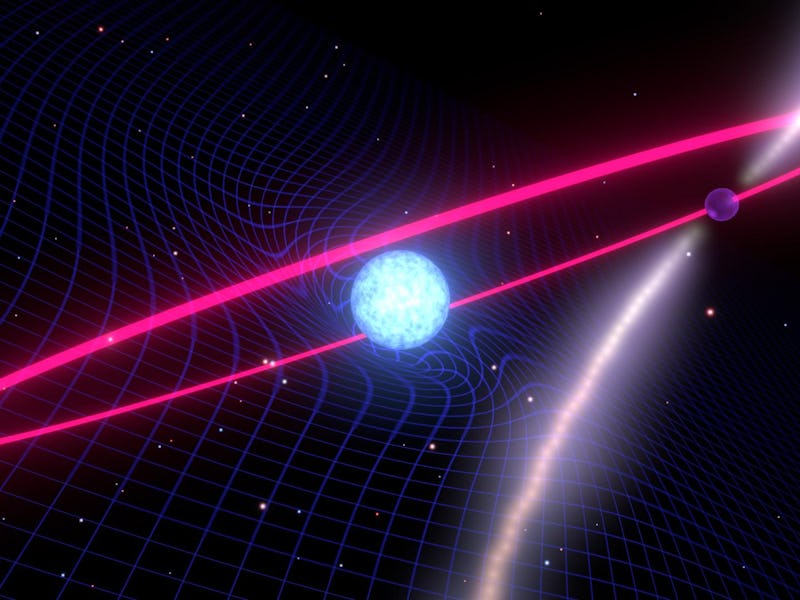Space-time warping star system confirms key aspect of Einstein's theory of general relativity
In a first, scientists have observed a binary-star pair so massive they drag the space-time continuum around them.

The stars in the binary-star system PSR J1141-6545 make up an eccentric pair. As they dance around each other in a rapid motion, the two stars drag space and time.
In 1918, Albert Einstein’s theory of general relativity predicted that the rotation of a massive object would warp space and time in its vicinity — essentially distorting the space-time continuum in a phenomenon known as ‘frame dragging.’
Now, a team of scientists were able to measure that effect in a binary-star system, revealing a mind-shattering deviation of space-time in the stars' wake.
The study, published Thursday in the journal Science, confirms Einstein's theory in a distant binary-star system for the first time.
A mischievous pair
PSR J1141-6545 was first discovered in 1999. It consists of a radio pulsar star and a large white dwarf orbiting around each other. The stars are separated by a short distance of some 865,000 miles — around the same distance as the diameter of the Sun. Incredibly, the pulsar orbits its partner white dwarf at a maximum speed of a million kilometers per hour.
Ever day, the pair complete five orbits, frantically hurtling around each other in a fast-paced cosmic dance.
If this were any ordinary binary system, the pulsar star would have formed before the white dwarf. But previous theoretical models of the system suggest it was the white dwarf that came to be first.
Until now, scientists had been unable to measure the rotation of the white dwarf star because it is too faint to study through its spectral lines.
But the team behind the new study found a way to measure its rotation using its companion. They used the radio signals from the pulsar to track its orbit over a period of 20 years. From these data, they were able to make a precise measurement of the size and orientation of the pair's orbit.
From that, the team detected a deviation of space-time that caused a shift in the orbital orientation of the stars.
The team detected a 150 kilometer deviation in the pulsar’s orbit over 20 years. Essentially, the pair had to be dragging space-time around them.
By accurately measuring the orbit of the stars, the data also confirm that the white dwarf formed before its odd companion star.
The study suggests that, after it went supernova, the original star that birthed the pulsar transferred mass to the white dwarf, which resulted in an acceleration of the white dwarf’s rotation.
“Here Albert Einstein gave us a tool, which we can now use to find out more about pulsars and their companions in the future,’’ Matthew Bailes, a researcher at Swinburne University, Australia and co-author of the paper, said in the statement.
Earth and the space-time continuum
This effect has been seen before: Our own planet Earth drags the space-time continuum in its vicinity, too.
In 1998, a team of researchers and NASA scientists published the first direct evidence that Earth drags space and time behind it as it rotates on its axis. They did so by measuring shifts in the orbits of two Earth-orbiting, laser-ranging satellites, the Laser Geodynamics Satellite I (LAGEOS I) and its sister satellite, LAGEOS II.
The orbits of the two satellites shifted about six feet a year in the direction of the planet’s rotation.
“If LAGEOS-I was hypothetically orbiting this white dwarf, its orbit would precess by several degrees a day, as the dragging of space-time is about 100 million times stronger,” Norbert Wex, specialist in general relativity at the Max Planck Institute for Radio Astronomy, and co-author of the new study, said in a statement.
The team is hoping that with the launch of new, more technologically sophisticated radio telescopes, they can detect more odd pairings like this binary star system that display the real-time effects of general relativity in action.
An artist's concept of the discovery of the binary star pair.